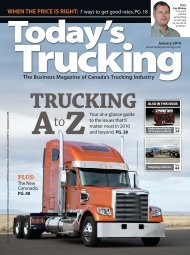You also want an ePaper? Increase the reach of your titles
YUMPU automatically turns print PDFs into web optimized ePapers that Google loves.
Magic Gas?<br />
tech tips Nitrogen tire fills are nothing new, but new technology<br />
makes it affordable for truck fleets of all sizes. By Jim Park<br />
There’s nothing magical about<br />
nitrogen’s ability to prolong tire<br />
life. It won’t restore the original<br />
luster to the innards of your tires, it doesn’t<br />
smell better, and neither will it save the<br />
environment. But using nitrogen rather<br />
than compressed air to inflate tires has<br />
two principle advantages. First, its permeation<br />
rate is 35 percent slower than air,<br />
resulting in tires that stay properly inflated<br />
longer, keeping tires running cooler,<br />
improving tread life, minimizing sidewall<br />
flex, and overall, lowering the rate of pressure-induced<br />
blowouts. Second, nitrogen<br />
is dry and contains no moisture. Nitrogen<br />
is inert so rust cannot form since there is<br />
neither oxygen nor moisture present to<br />
cause oxidation of the wheel.<br />
Remove the oxygen and the moisture<br />
PSSST: Nitrogen’s better<br />
than air in your tires.<br />
from inside your tires and replace it with a<br />
gas that stays in place longer, runs cooler,<br />
and won’t corrode the inner surfaces of<br />
the wheel rim or the tire and you’ve solved<br />
many of your tire management issues—all<br />
at once.<br />
Until recently, there has not been a convenient,<br />
reliable, economic means of distributing<br />
nitrogen to inflate tires. <strong>In</strong> the<br />
past, nitrogen would be provided in large<br />
liquid tankers transferring the nitrogen to<br />
large on-site storage vessels, or it was<br />
delivered in high-pressure cylinders. But<br />
recently, technologies<br />
have been developed<br />
for on-site use that<br />
purifies regular compressed<br />
air into high<br />
purity nitrogen.<br />
<strong>In</strong> <strong>Gear</strong><br />
There are two types of nitrogen generating<br />
systems: membrane generators and<br />
pressure swing adsorber generators<br />
(PSA). Both produce 98-to-99-percent<br />
pure nitrogen, but the PSA generators are<br />
typically rated for less than 90 psi output—a<br />
little weak for heavy-duty truck<br />
applications, but suitable for light- and<br />
medium-duty trucks. The output of<br />
membrane generators, however, is equal<br />
to the input pressure.<br />
The nitrogen generators are rated for<br />
certain volumes. Higher volume units are<br />
capable of filling over 30 truck tires per<br />
hour from 150-psi compressed air systems.<br />
There are no storage reservoirs required,<br />
as the nitrogen is used as it’s produced.<br />
The definitive study on nitrogen-filled<br />
truck tires, “Million Mile Truck Tires—<br />
Available Today” was conducted in 1986<br />
by Lawrence Sperberg<br />
and clearly demonstrates<br />
the advantages<br />
of using nitrogen for<br />
truck tire inflation.<br />
Sperberg found in a<br />
MARCH 2006 65



